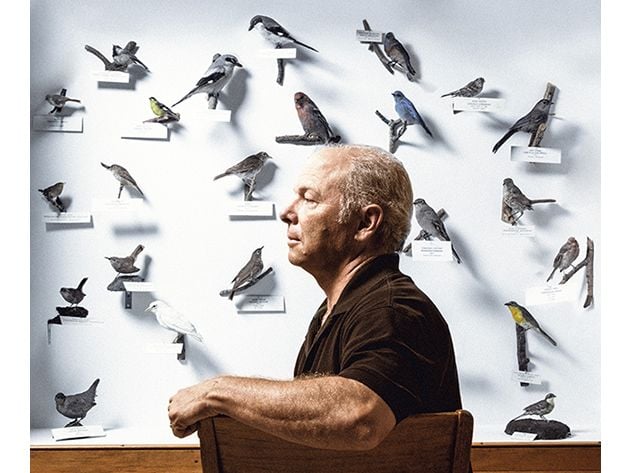The Toxins That Affected Your Great-Grandparents Could Be In Your Genes
Biologist Michael Skinner has enraged the chemical community and shocked his peers with his breakthrough research
/https://tf-cmsv2-smithsonianmag-media.s3.amazonaws.com/filer/Skinner-ingenuity-birds-main-631.jpg)
Michael Skinner’s biggest discovery began, as often happens in science stories like this one, with a brilliant failure. Back in 2005, when he was still a traditional developmental biologist and the accolades and attacks were still in the future, a distraught research fellow went to his office to apologize for taking an experiment one step too far. In his laboratories at Washington State University, she and Skinner had exposed pregnant rats to an endocrine disruptor—a chemical known to interfere with fetal development—in the hope of disturbing (and thereby gaining more insight into) the process by which an unborn fetus becomes either male or female. But the chemical they used, an agricultural fungicide called vinclozolin, had not affected sexual differentiation after all. The scientists did find lower sperm counts and decreased fertility when the male offspring reached adulthood, but that was no surprise. The study seemed like a bust.
By accident, though, Skinner’s colleague had bred the grandchildren of those exposed rats, creating a fourth generation, or the great-grandchildren of the original subjects. “It’s OK,” Skinner told her. “You might as well analyze them.” If nothing else, he thought, the exercise might take her mind off her mistake. So she went ahead and studied the rats’ testes under a microscope.
What they found would not only change the direction of Skinner’s research but also challenge a bedrock principle of modern biology. And Skinner would become the forerunner of a new way of thinking about the possible long-term health consequences of exposure to environmental chemicals.
His discoveries touch on the basic question of how biological instructions are transmitted from one generation to the next. For half a century it has been common knowledge that the genetic material DNA controls this process; the “letters” in the DNA strand spell out messages that are passed from parent to offspring and so on. The messages come in the form of genes, the molecular equivalent of sentences, but they are not permanent. A change in a letter, a result of a random mutation, for example, can alter a gene’s message. The altered message can then be transmitted instead.
The strange thing about Skinner’s lab rats was that three generations after the pregnant mothers were exposed to the fungicide, the animals had abnormally low sperm counts—but not because of a change in their inherited DNA sequence. Puzzled, Skinner and his team repeated the experiments—once, twice, 15 times—and found the same sperm defects. So they bred more rats, and tested more chemicals, including substances that lead to diseases in the prostate, kidney, ovaries and immune system. Again and again, these diseases also showed up in the fourth- and fifth-generation offspring of mothers exposed to a chemical.
“In essence,” Skinner explains, “what your great-grandmother was exposed to could cause disease in you and your grandchildren.”
And, startlingly, whatever disease pathway a chemical was opening in the rats’ fur-covered bodies, it did not begin or end at a mutation in the genetic code. Skinner and his team found instead that as the toxins flooded in, they altered the pattern of simple molecules called methyl groups that latch onto DNA in the fetus’ germ-line cells, which would eventually become its eggs or sperm. Like burrs stuck to a knit sweater, these methyl molecules interfered with the functioning of the DNA and rode it down through future generations, opening each new one to the same diseases. These burrs, known to be involved in development, persisted for generations. The phenomenon was so unexpected that it has given rise to a new field, with Skinner an acknowledged leader, named transgenerational epigenetics, or the study of inherited changes that can’t be explained by traditional genetics.
A study by Skinner and colleagues published last year in the journal PLOS One has upped the ante considerably. The burrs were not just haphazardly attached, Skinner found. Instead, they fastened themselves in particular arrangements. When he bathed the insides of his pregnant rats in bug spray, jet fuel and BPA, the plastics component recently banned from baby bottles, each exposure left a distinct pattern of methyl group attachments that persisted in the great-grandchildren of exposed rats.
Not only is your great-grandmother’s environment affecting your health, Skinner concluded, but the chemicals she was exposed to may have left a fingerprint that scientists can actually trace.
The findings point to potentially new medical diagnostics. In the future, you may even go to your doctor’s office to have your methylation patterns screened. Exposure of lab rats to the chemical DDT can lead to obesity in subsequent generations—a link Skinner’s team reported in October. Hypothetically, a doctor might someday look at your methylation patterns early in life to determine your risk for obesity later. What’s more, toxicologists may need to reconsider how they study chemical exposures, especially those occurring during pregnancy. The work raises implications for monitoring the environment, for determining the safety of certain chemicals, perhaps even for establishing liability in legal cases involving health risks of chemical exposure.
These possibilities have not been lost on regulators, industries, scientists and others who have a stake in such matters. “There are two forces working against me,” Skinner says. “On one side, you have moneyed interests refusing to accept data that might force stronger regulations of their most profitable chemicals. On the other side, you have genetic determinists clinging to an old paradigm.”
***
Michael Skinner wears a gray Stetson with a tan strap, and leans back easily in his chair in his office on the Pullman campus. His fly-fishing rod stands in the corner, and a colossal northern pike is mounted on the wall. An avid fly fisherman, Skinner, age 57, was born and raised on the Umatilla Indian Reservation in eastern Oregon. The Skinners are not of Indian descent, but his parents owned a family farm there—“a good cultural experience,” he says. His father worked in insurance, and he and his four brothers grew up just as five generations of Skinners had before them—hunting and fishing and cowboying, learning a way of life that would sustain them into adulthood.
He loved the outdoors, and his fascination with how nature worked prompted a school guidance counselor’s suggestion that a career in science might be just the thing. He was about 12, and true to form he stuck with it. In high school and then at Reed College he wrestled competitively, and today his supporters and critics alike may detect a bit of his old grappling self in how he approaches a problem—head-on. “It probably taught me how to confront, rather than avoid challenges,” he says now. The sport also led him to his future wife, Roberta McMaster, or Bobbie, who served as his high-school wrestling team’s scorekeeper. “I was fascinated that someone so young knew exactly what he wanted to do with his life,” Bobbie recalls. He proposed marriage before heading for college, and the two have been together ever since and have two grown children.
He attended Washington State University for his PhD in biochemistry, and during that time he and Bobbie often lived on game that he’d hunted. It was not unheard of to find a freshly killed deer hanging in the carport of their student housing. “They were lean years,” Bobbie says. “But they were good ones.”
After positions at Vanderbilt and the University of California, San Francisco, Skinner returned to Washington State University. “I wanted a big research college in a rural town,” he says. He spent the next decade studying how genes turn on and off in ovaries and testes, and how those organs’ cells interact. He wasn’t aiming to take on the central idea in biology for much of the 20th century: genetic determinism, the belief that DNA is the sole blueprint for traits from hair and eye color to athletic ability, personality type and disease risk.
In some sense this interpretation of genetic determinism was always oversimplified. Scientists have long understood that environments shape us in mysterious ways, that nature and nurture are not opposing forces so much as collaborators in the great art of human-making. The environment, for example, can ramp up and pull back on gene activity through methyl groups, as well as a host of other molecules that modify and mark up a person’s full complement of DNA, called the genome. But only changes in the DNA sequence itself were normally passed to offspring.
So certain was everyone of this basic principle that President Bill Clinton praised the effort to complete the first full reading of the human genome, saying in June 2000 that this achievement would “revolutionize the diagnosis, prevention and treatment of most, if not all human diseases.” When stacked against such enthusiasm, Skinner’s findings have felt like heresy. And for a while, at least, he was criticized accordingly.
***
Critics of the Skinner-led research pointed out that the doses of vinclozolin in his rat studies were way too high to be relevant to human exposure, and injecting the rats as opposed to administering the toxins through their food exaggerated the effects. “What he’s doing doesn’t have any real obvious implications for the risk assessments on the chemical,” EPA toxicologist L. Earl Gray was quoted telling Pacific Standard magazine back in 2009. Until the results are replicated, “I’m not sure they even demonstrate basic science principles.”
Skinner responds to assaults on his data by saying that risk assessment, of the type that toxicologists do, has not been his goal. Rather, he’s interested in uncovering new biological mechanisms that control growth, development and inheritance. “My approach is basically to hit it with a hammer and see what kind of response we get,” he says. He remains calm, even when called on to defend that approach. “Conflicts with individuals solve very little,” he says. “The best way to handle these things is to let the science speak for itself.”
That science has received a lot of attention (the vinclozolin study has been cited in the scientific literature more than 800 times). Recently, the journal Nature Reviews Genetics asked five leading researchers to share their views on the importance of epigenetic inheritance. A “mixture of excitement and caution,” is how the editors described the responses, with one researcher arguing that the phenomenon was “the best candidate” for explaining at least some transgenerational effects, and another noting that it might, if fully documented, have “profound implications for how we consider inheritance, for mechanisms underlying diseases and for phenotypes that are regulated by gene-environment interactions.”
Though most of Skinner’s critics have been reassured by new data from his lab and others, he says he still feels embattled. “I really try to be a scientist first and foremost,” he says. “I’m not a toxicologist, or even an environmentalist. I didn’t come to this as an advocate for or against any particular chemical or policy. I found something in the data, and I pursued it along a logical path, the way any basic researcher would.”

